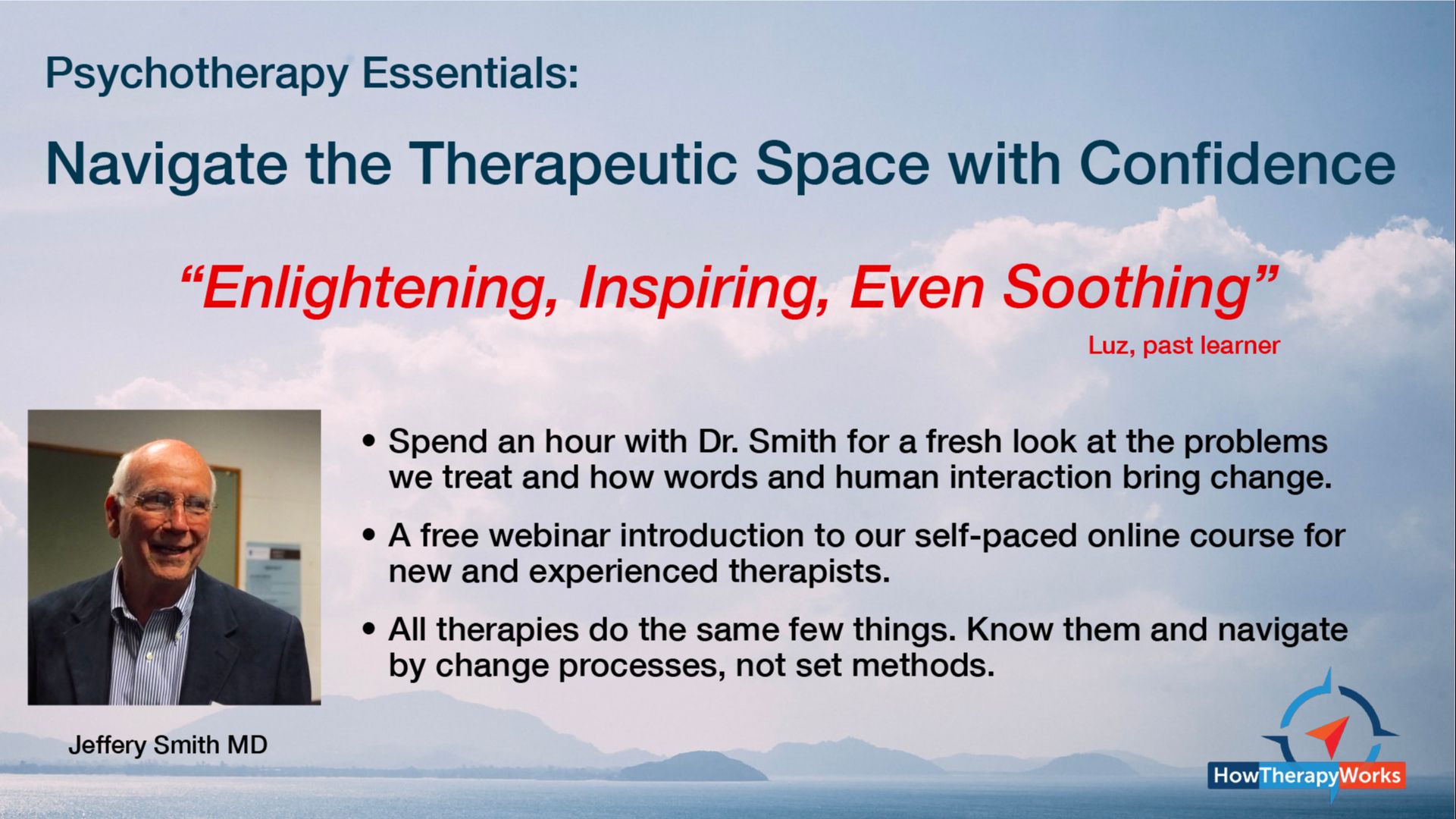
First, announcing a Free Webinar and New Course:
Psychotherapy Essentials: Navigate the Therapeutic Space with Confidence
An online course and free introductory webinar for new and experienced therapists–
Many therapists suffer from the lack of an accessible and practical framework for navigating the variety and complexity of problems we work with as well as the confusing number of techniques available. Howtherapyworks.com is pleased to introduce a new course and introductory webinar:
Jeffery Smith, MD, Leader of the Psychotherapy Caucus of the American Psychiatric Association and President Elect of the Society for the Exploration of Psychotherapy Integration, says the answer is easier than one might think.
“Opportunity comes from a gap in knowledge that can, at last, be filled. Until recently, no one knew how words and human interaction lead to change in the problems we treat. That’s the infrastructure of psychotherapy and it applies to all problems and all therapies.”
The new, self-paced, online course gives learners an efficient way to make sense of the problems we treat and the foundational processes by which familiar therapeutic techniques do their work.
Click Here: Learn More and Join the Introductory Webinar
TIFT #86: Modernizing Psychotherapy
Psychotherapy has become overcomplicated and fragmented. New treatments create uncertainty with each claiming to have the answer. In the confusion, too many therapists fall back on just being good listeners. The solution is easier than one might think. We have an opportunity because, until recently, no one knew quite how words and human interaction could bring about change to the problems we treat. That’s the infrastructure of psychotherapy, where recent science helps bring clarity to the problems we treat and puts us on track to solve the mystery of how therapy works.
Keep what we already have
Understanding the infrastructure of psychotherapy, that is, how people develop the problems we work with and how technique leads to change, fills in what was missing but does not invalidate the vast amount of wisdom, observation, and research already collected. 
In the tree image, the branches and foliage represent existing therapies, invented at a time when the underlying change mechanisms were still a mystery. At last it is possible to add the trunk and roots to our knowledge. That means knowing why people respond in ways that are maladaptive and understanding the specifics of how words and relationship are able to support change.
How science validates what we already know
What makes this new knowledge exciting is how it gives scientific validation to what the field has known from intuition and experience. The highlight is what science says about the necessary requirements for memory reconsolidation. They are activating the old maladaptive pattern in the limbic system and providing new, disconfirming information to replace the old. Those two requirements map very closely to things every therapy seeks to do.
The reader may recognize that techniques from various therapies accomplish the first requirement, activating the old pattern. Exposure therapy, transference, and psychodrama are three good examples. The second requirement, provision of disconfirming information begins to make sense when we realize that the new information is often nonverbal or even bodily. A soothing tone of voice is information that disconfirms the limbic system’s appraisal of danger. Sometimes verbal interpretations or pointing out illogic can work as well. In trauma, bodily movement may be the only way to disconfirm the limbic experience of powerlessness.
In science, when a new theory or explanation surprises by confirming seemingly unrelated findings, it gives one a sense of confidence in both the science and in what we already know.
Science improves upon current practice
Clarity about the clinical requirements for memory reconsolidation helps sharpen existing techniques by making crystal clear how and why they work. For example, it is not useful, in itself, to correct conscious knowledge. Rather, what needs to be corrected is the implicit understanding located in the limbic system, which needs to be accessed through consciousness. Another example is the well researched benefit of in-session emotion. Emotion is not helpful for its own sake, but because it is the clinician’s indicator that the old maladaptive pattern has become activated in the limbic system, making it accessible to change.
The better we understand the requirements for the known change mechanisms, the sharper our technique can become. In a quiet way, therapeutic decision making becomes focused not on following a method, but on listening to the limbic system and confronting old patterns with new information in nonverbal, circumstantial, verbal, and bodily forms.
Let's not forget the art of psychotherapy
The study of the neurophysiology of change had been criticized as reductionistic. In fact, what it clarifies is that critical change processes take place in the limbic system. That means it is vital to listen and communicate in terms that resonate beneath the cortex. We can think of a channel between consciousness and the limbic system, where words and conscious logic are not native. There, stories, poetry, personally evocative words, images, associations, and all kinds of nonverbal data are the native “language.” Much of the art of psychotherapy is being able to hear and to speak that language and the unique dialect possessed by each individual.
An Essential Framework
Fortunately, the infrastructure applicable to all therapies is not overly complex. In our webinar and course we break it down to looking at how evolution and individual development lead to maladaptive patterns, how three known change mechanisms can modify problem responses, the clinical requirements for those mechanisms, and, finally, four nonspecific factors also needed for success.
Jeffery Smith MD
Click Here: Learn More and Join the Introductory Webinar
Free Resources
1. Video interview with Dr. Smith
2. Open Access, article from the Journal of Psychotherapy Integration.
3. Substack: Therapy Lab: Solving the Tough Cases, Discussion with Dr. Smith
4. Read the explanatory post and get Five Key Questions to guide any therapy.
5. Podcast course: 25 episodes following Dr. Smith's "nondenominational" textbook, Psychothrapy: A Practical Guide.
6. Free e-book for clients, Getting the Most from Your Therapy.
7. Join our mailing list to get the Infographic & Free e-book: The Common Infrastructure of Psychotherapy, as well as bi-weekly essays and occasional news and updates. Unsubscribe at any time. Click below.
We hate SPAM. We will never sell your information, for any reason.


